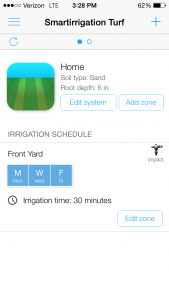
by Blake Thaxton | Jun 10, 2014
In this age of tablets, smart phones, and whatever they come up with next, even the gardener can benefit from new technology. Although gardening and landscaping to beautify our surroundings is a way to connect with the past, there are many new tools that are ready to help! Here are a few web sites and phone apps that may prove useful to the gardener.
Sod Solutions has made it easy to know how much sod you need to order by using a mapping system to create overlays that measure square footage. Measuring square footage can prove tough for irregularly shaped beds or turf lawns. This website can help measure accurately so one can also apply the correct amount of herbicides, pesticide, or fertilizer. The website can be difficult for the technology challenged among us. An easy solution is to find anyone under the age of 15 and they should be able to help!
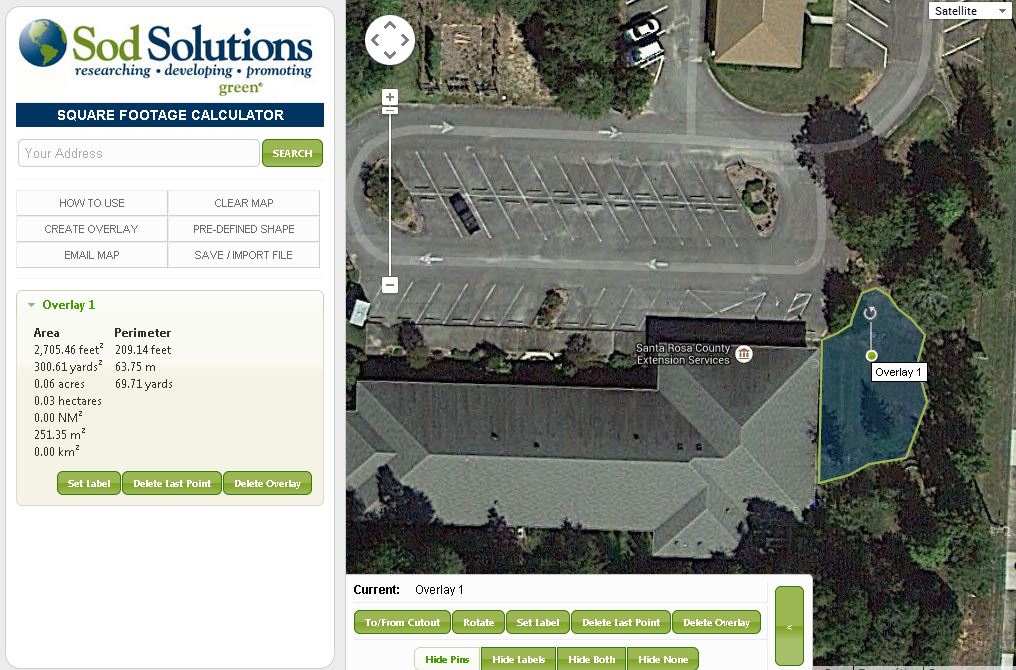
The Smartirrigation Turf app is designed to help homeowners with automatic irrigation systems in scheduling their watering times correctly. This app takes everything into account from soil type to local weather conditions. For example, you set a watering schedule for Zone X of 15 minutes every Monday, Wednesday, and Friday. Then, it does not rain for an extended period of time. Because your lawn does not get the supplemental rain that was predicted, the app may tell the home owner to change the setting to 25 minutes. To read more about using the app correctly, click on the link above.
Other apps that might prove useful are:
- NCSU Lawn Care App – An App by North Carolina State University all about lawn care.
- SoilWeb for Iphone – Produced by The California Soil Resource Lab that will tell you what kind of soil you are standing on.
- Leaf Snap – Developed by Columbia University, University of Maryland, and Smithonian Institution. The app uses visual recognition software to identify plants by taking pictures of its leaves.
by Julie McConnell | May 3, 2014
The last week of April 2014 brought with it 10-22 inches of rain across the panhandle in a matter of days. Some areas had immediate flooding and standing water, while others may be in areas at risk of rising rivers and streams. As the water recedes, many people are wondering how all the water will affect their landscapes.
Only time will tell what the long term impact will be, but here are a few things to watch for and what you can do to try to moderate damage.
- Let soils dry out before driving vehicles or other equipment on grassy areas. Even if the water is not visible, if the soil is still saturated, driving lawn equipment or cars may cause ruts.
- Do not leave automatic irrigation systems running on established shrubs, trees, and lawns. If your system is set to run in the early morning hours, you may not think about it being on, check your systems and hold off on adding water until soils dry out and the plants need it.
- Watch for fungus symptoms and treat if needed. Wet plants and cool weather are ideal for some Brown Patch on lawns, be aware and monitor landscapes closely. If disease is suspected, contact your local county extension office for recommendation.
- When mowing, leave a longer leaf blade to compensate for root stress.
- Look at the base of trees and shrubs to make sure silt and sand have not buried the crown or root flare. Also look for erosion of root zone, these areas may need correction. “Salvaging Flood-Damaged Shrubs and Ornamentals.”
- Adjust fertilization as needed; if you recently applied fertilizer it has likely runoff or leached from the site. However, if you suspect fungal disease do not fertilize until disease is managed.
- Stress in turfgrass, for details read “Watch Turf for Flooding Stress”
- You may see new weeds (seeds or segments may have washed or blown into your yard)
- Tree and shrub decline or death read “We Had Plenty of Rain, Why are My Trees Dying?”
- Although this storm was not a hurricane, “Assessing Damage and Restoring Trees After a Hurricane” has helpful information for areas with wind damage
- Nutritional deficiency symptoms in palms may show up 4-5 months from now. “Nutrient Deficiencies of Landscape and Field-grown Palms in Florida.”
- Decreased availability and increased price of sod (flooded fields prevent harvest and increase inputs for disease, weed, and nutrition management)
- Scheduling changes or maintenance adjustments by landscape contractors. Turfgrass and ornamentals will likely need different maintenance applications than in years past to correct issues related to flooding and excess rain.
by Julie McConnell | Apr 21, 2014

Captiva St. Augustinegrass Credit: Julie McConnell, UF/IFAS
Mowing is an important and often overlooked landscape best management practices that can increase lawn health.
Most of us mowed lawns to earn some spending money as kids. As long as it was shorter when we finished than when we started our customers were happy. Although mowing seems like a simple chore that anyone can do, it turns out that improper mowing can cause a lot of damage to lawns and can increase pest and disease issues.
Make sure your lawn mower in good working order. Ensure the blades are sharp and the engine is not leaking any oil or gas products that may damage your lawn. Dull or damaged blades will give a ragged cut to grass blades that make it easier for disease and insects to attack your lawn. Leaking fuel products can damage or kill turf. Keep your mower clean by blowing or rinsing it after use, this simple step will also reduce the spread of weeds, insects, and disease.
Know the recommended mowing height for your type of turf (see table below) and follow it! Cutting turf below the recommended height places stress on the grass and encourages shallow roots. Deep roots help turf handle stresses such as drought, shade, insects, disease, or traffic. If any of these circumstances are occurring, the mowing height should be increased and fertilization should be decreased.
Mowing Height Table
| Turfgrass Type |
Recommended Mowing Height |
| Bahiagrass |
3.0-4.0 inches |
| Bermudagrass |
0.75-1.5 inches |
| Centipedegrass |
1.5-2.5 inches |
| St. Augustinegrass |
3.5-4.0 inches, Dwarf Cultivars 2.0-2.5 inches |
| Zoysiagrass |
1.5-2.5 inches, cultivar dependent |
When mowing, never remove more than 1/3 of the leaf blade per cutting. If the grass is overgrown, plan to mow in stages to avoid scalping or removing too much of the leaf blade. Just like shrubs, turf needs leaf surface area for photosynthesis. Allow clippings to fall onto lawns rather than catching them or discharging onto hard surfaces. The grass will decompose rapidly and provide nutrients to the lawn. Clippings that are blown onto sidewalks, streets, or other hard surfaces may be washed into storm drains and get into water systems. Just as decomposed clippings provide helpful nitrogen and phosphorus to our lawns, these same nutrients are harmful to our water bodies. Keeping them in lawns is a great way to recycle and to keep our water clean.
To learn more about caring for your turf click on the link below.
Bahiagrass for Florida Lawns
Bermudagrass for Florida Lawns
Centipedegrass for Florida Lawns
St. Augustinegrass for Florida Lawns
Zoysiagrass for Florida Lawns
by Mary Salinas | Sep 23, 2013
Is the newest growth on your sago palm turning yellow, brown, frizzy looking and dying – is it a pest or disease or something else?

Photo credit: Mary Derrick
This sago palm is suffering from a classic case of manganese deficiency. When sago palms lack manganese, the newest leaves will develop yellow splotches or be entirely yellow. As the leaves die, they turn brown and take on a frizzled appearance. Sometimes the leaves or fruit may be smaller than normal. If left unchecked, the sago usually dies.
Manganese is a micronutrient required by all plants for normal, healthy growth and is most available for plant uptake when the soil pH is between 5.5 and 6.5. Soils in the Florida panhandle are often naturally low in manganese and then what available manganese is present can be unavailable for the plant to use if the pH of the soil is much above 6.5. Also, manganese tends to be leached from the soil when the pH is below 5.5. Soil pH and nutrient testing is useful to determine if soils are nutrient deficient. Contact your county Extension office for information on getting that done.
[notice]Before treating, rule out an infestation of Asian cycad scale. Click here for a UF IFAS Extension publication on this damaging insect. Be aware that both are common problems for sago palms and that your sago may be afflicted with both![/notice]
If this is happening to a sago palm, the good news is that it is easy to correct. Manganese sulfate is readily available at garden centers, feed &seed stores and independent nurseries. Just make sure to get manganese sulfate and don’t confuse it with magnesium sulfate (Epson salts). The amount of manganese sulfate necessary to correct this deficiency will vary with its size, soil type and pH. Sago palms in sandy, acidic soils require less manganese sulfate than those in high pH soils. One ounce is sufficient for a very small plant in sandy, acidic soil. A very large sago in a high pH soil may require about five pounds, however. Spread the product evenly over the root zone and water in with about a half inch of water.
The affected leaves cannot be cured but new growth should return to normal. If the new growth is still affected, an additional application of manganese sulfate may be needed. Once sago palms have suffered from a manganese deficiency, half the initial rate should be applied yearly to prevent the deficiency from re-occurring.
Even though sago palms are not true palms – they are cycads – their nutritional needs are very similar to palms. Most of the time they grow well without any supplemental fertilization, but if they do need fertilizing, use a 8-2-12-4 (the fourth number is magnesium) palm fertilizer with micronutrients and avoid using other fertilizer products in their root zones.
For more information on sago palms please see:
Cycas revoluta, Sago Palm
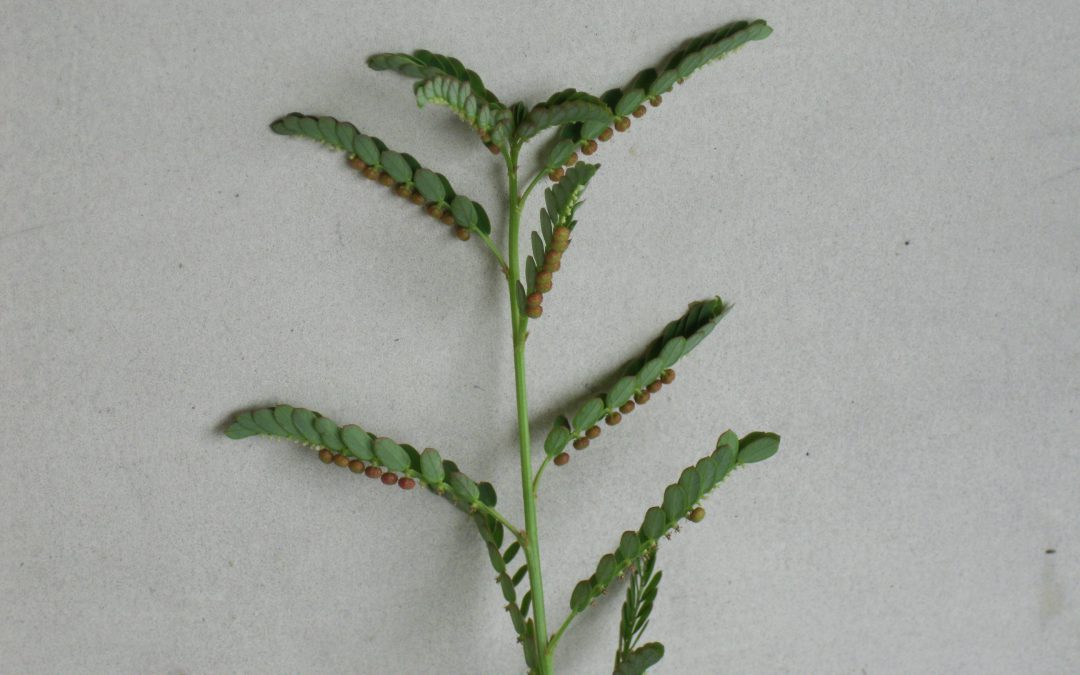
by Julie McConnell | Aug 5, 2013
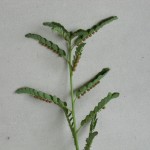
Chamberbitter
Above average rainfall this summer has supplied water to more than just our landscapes, weeds are benefiting and flourishing as well.
Just as with any other landscape pest, proper weed control starts with accurate identification and knowledge about the life cycle of the weed.
When weeds are low in number, mechanical control (pulling, mowing) is a good start. If weed population continues to increase and herbicide options are considered, several questions need to be answered before product application.
Questions you need to ask yourself about your weed and site:
- What weed(s) are you trying to control?
o Be sure you know what the name of the weed is so that you can find it on your product label “weeds controlled” list; if you need help with identification contact your local county extension office
- What is your site?
o Lawn – specific turfgrass is important, what is safe to use on one type may kill another
o Ornamental beds – again note specific plants near your treatment area in case of sensitivity
o Water bodies – some herbicides are not labeled for use within a given distance of water; if the weed is in or around the water only use herbicides listed for aquatic weed control
- What is the life cycle of your weed?
o Annual – one season life cycle, summer annuals complete their life cycle between spring and fall; winter annuals are active between fall and spring
o Biennial – two growing season life cycle
o Perennial – plant lives for three or more years
- What category does your weed fall into?
o Grasses – one seed leaf as it emerges from the soil; hollow, rounded, stems with nodes, parallel veins in true leaves; examples are crabgrass, dallisgrass, cogongrass, torpedograss
o Broadleaves – have two seed leaves and true leaves have net-like veins and usually have showy flowers; examples are lespedeza, dollarweed, clover, chickweed, henbit, florida betony
o Sedges/Rushes – sedges have solid triangular stems; rushes have round stems; both like moist or wet habitat; examples are purple nutsedge, yellow nutsedge, beak rush
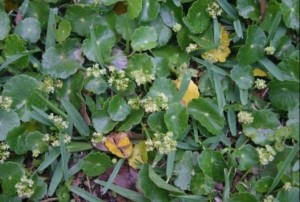
Dollarweed: Image Credit Edis ENH1128
Basic information about herbicide categories:
For more information read EDIS Publication “Weed Management in Home Lawns”

